The trial of Ernst August König, a resident of Berleburg, took place in Siegen in 1987. König was in charge of having committed crimes in the so-called Gypsy camp of Birkenau. I attended the proceedings so that I could give a report to the Hamburg Auschwitz Committee…One day during the trial, a former SS man by the name of Kühnemann was called as a defense witness. I was puzzled when I saw him enter the courtroom. The way he moved seemed strangely familiar to me. But I didn’t really know who he was until he started to speak. I became quite upset and talked to the public prosecutor during the recess in the proceedings. I told him that this was the same man who in March 1943 had killed Max Rosenstein’s child by smashing its head against a pole…The public prosecutor instituted preliminary proceedings against Kühnemann and subsequently filed charges against him. There were a number of witnesses for the prosecution. But in 1995, after the trial in Duisburg had gone on for nearly two years, the proceedings were postponed indefinitely because by that time Kühnemann was supposedly too old or too sick to stand trial.
THE UNWELCOME ONE
By Hans Frankenthal
In his final opinion the judge at the Nuremberg trial wrote:
In defiance of military needs, in spite of economic demands, and against every rule of reason, incalculable manpower was being wildly killed off…For a country at war nothing can be more vital than that ammunition reach the soldiers holding the fighting fronts. Yet, in one massacre in Sluzk, vehicles loaded with ammunition for the armed forces were left standing in the streets because the Jewish drivers, already illegally forced into this service had been liquidated by the Execution Battalions.
On September 15, 1947, the commander of Einsatzgruppen D, Otto Ohlendorf, stepped into the courtroom for the Einsatzgruppen trial. Handsome, poised, polite, dignified, and forty years of age – the man was a compelling personality. The killing was unpleasant to him, he said, but he knew he was destroying dangerous people. And the children? Well, the children were killed because of permanent security problems. They would surely grow up, he testified, and the children of parents who had been killed would constitute a very real danger to the State.
HITLER’S DEATH CAMPS
By Konnilyn G. Feig
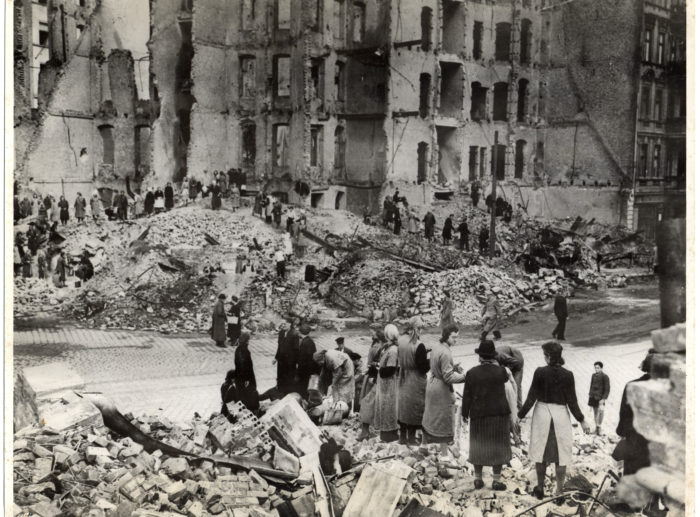
Women remove the rubble from the streets of Berlin.
On April 15, the British finally entered Bergen-Belsen, bringing reporters and cameramen with them to document the 60,000 “living skeletons” who staggered toward their jeeps. An Evening Standard journalist wrote, “The indignity of death above ground – the bared teeth, the revealed frame that should be sacred, and once was sacred to some loved one, the piled bodies in their ghastly grayness, the pitiable little thing with claws instead of a hand that was a baby, still within the protecting grasp of an emaciated bone that was once a mother’s arm – all on the Nazi death heap.”
HUNTING EICHMANN
By Neal Bascomb
In July 1991, shortly after the fall of the Soviet Empire, Romania’s chief rabbi, Moses Rosen, commented that the masses of the Romanian Jews killed during the world war “were murdered twice,” because for a half century afterward a fact widely known elsewhere was denied or never acknowledged in Romania – more than 211,000 Romanian Jews died during the war, most murdered by their own government. Moreover, Romanian armies invading the Soviet Union with German forces after 1941 assisted the Germans in murdering tens of thousands of Jews in Bessarabia and Bukovina, lands recovered by Romania from the Russians. In the fall of 1941, Romanian troops carried out in the soviet Black Sea port of Odessa the largest single massacre of Soviet Jews.
NAZIS AFTER HITLER
By Donald M. McKale
Hans Friedrich, an ethnic German from Romania, participated personally in these ‘pit’ killings as a member of the 1st SS Infantry Brigade. Friedrich says he had ‘no feelings’ as he shot the Jews…Petras Zelionka was a member of the Lithuanian unit that took part in the killings…Even after the war was over – Zelionka was interviewed in 1996 and Friedrich eight years later – neither expressed any remorse for their actions, and they both talked about the killings as if they had gained some base, sadistic kick out of murdering in this intimate way. Friedrich, for example, says that the Jews “were extremely shocked, utterly frightened and petrified, and you could do what you wanted with them,” and Zelionka that he felt a sense of “curiosity” as he killed the children – “you just pull the trigger, the shot is fired and that is it.”
THE HOLOCAUST
By Laurence Rees
{Twenty-two} commanders and officers of Einsatzgruppen organizations were brought to trial in Germany by the U.S. military government after the war…All twenty-two defendants were convicted on at least one of three counts of indictment (crimes against humanity, conventional war crimes, membership in an illegal organization). Fourteen were sentenced to death by hanging, two to life imprisonment, the remaining six to lesser sentences…In January 1951 U.S. High Commissioner John J. McCloy confirmed some sentences but reduced others, including ten of the fourteen death sentences…West German courts convicted and punished only 472 defendants in total for involvement in the persecution and murder of Jews. It follows that most Einsatzgruppen, Order Police, Totenkopf, Waffen-SS and other SS members who perpetrated mass murder in the East during the Second World War were neither indicted nor convicted but have lived out their lives in freedom, unpunished, a liberty they summarily denied their victims.
MASTERS OF DEATH
By Richard Rhodes
Germany is in a state of chaos. The end of the war sees its major cities and ports reduced to rubble, due to Allied air and ground bombardments. Simple amenities like running water and electricity are often nonexistent. There is little food or livestock. Piles of trash and human excrement singe the nostrils, an aroma made worse by decomposing corpses still in need of disposal. Throughout Germany, the Americans and British try to care for the millions displaced by war, building refugee camps to house and feed those with no place to go. An estimated twenty million people will fill the roads of Europe in the next six months, making the long march home before winter arrives.
KILLING THE ϟϟ
By Bill O’Rielly and Martin Dugard
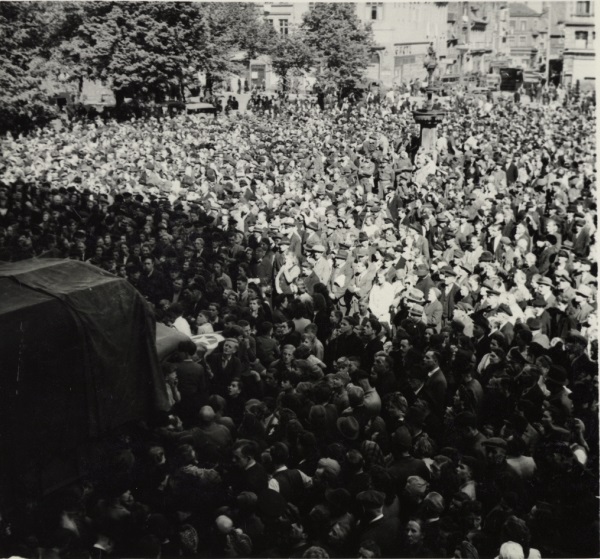
German civilians crowd around a broadcast truck announcing the unconditional surrender of Germany to the Allies.
Schwammberger’s Nazi career could be described as a modest success. Born in South Tirol in 1912, he became a party member in 1933, which put him in the class of opportunistic joiners rather than early believers. Sent to Cracow in 1939 as a low-ranking SS officer, he became commandant of a slave-labor camp, which was closed in 1942. The 200 surviving slaves were shot. He was promoted to the rank of Oberscharfȕhrer and became ruler of the ghetto in Przemysl, whose inhabitants were transported at regular intervals to Belzec and Auschwitz. His cruelty and sense of fun were not unusual for a man of his position: his favorite Alsatian, Prinz, was often set upon the Jewish prisoners and he was fond of killing people in front of their families. His postwar life was not untypical either, for a man of his ilk: he was helped by Catholic priests to escape to Argentina, where he lived in peace, devoting his time to beekeeping. He was only brought back to Germany in 1990; his trial began the following year.
THE WAGES OF GUILT
By Ian Buruma
Once the peace was secured, the Allies rapidly occupied Germany. Martial law was imposed, checkpoints were established at bridges and road intersections, curfews and blackouts were set, roving patrols were sent out, and Wehrmacht soldiers were interned in POW camps. The aim was to secure the country, to prevent the development of an organized underground resistance, and to provide routine policing to restore public order without delay.
HUNTING EICHMANN
By Neal Bascomb
Contrary to the impression created by the Hollywood movie The Sound of Music, most Austrians did not oppose the German invasion. In fact, the Anschluss sparked vicious displays of anti-Semitism within Austria. Austrian Gentiles, sometimes urged on by Germans but often acting on their own, seized the opportunity to assail their Jewish compatriots. They stole their property, harassed and beat them, and subjected many to public rituals of humiliation. For example, in Vienna, crowds took delight in forcing professors, artists, journalists, and other prominent Austrian Jews to scrub streets with toothbrushes. Decades after the war a small statue in Vienna commemorates the ‘Jew with a toothbrush’ and reminds Austrians of the complicity of ordinary people from their country in the crimes of Nazism.
THE HOLOCAUST: A CONCISE HISTORY
By Doris L. Bergen
At Nordhausen they found piles of dead and dying bodies in the same hut, lying in their own excrement and filth. Among the dead, they discovered emaciated children.
A U.S. congressional delegation inspected three concentration camps in May 1945. At Dora they found piles of dead bodies and thousands of dying inmates. One representative said of the SS: “They reached depths of human degradation beyond belief and constituted no less than organized crime against civilization and humanity for which swift, certain, and adequate punishment should be meted out to all those who were responsible.”
HITLER’S DEATH CAMPS
By Konnilyn G. Feig
Colonel Robert Matteson, a thirty-one-year-old Harvard Educated CIC officer attached to the U.S. Third Army, drove his troops into Altaussee. He had been tipped off that Kaltenbrunner was in the area with his mistress… A few days later, another tip came from a local Austrian resistance fighter that Kaltenbrunner, his adjunct, and two SS guards were hiding in a hunting cabin high in the Totengebirge. Guided by four former Wehrmacht soldiers who knew the territory and backed by an American infantry squad, Matteson climbed into the mountains, disguised in Lederhosen, an Alpine jacket, and spiked shoes. The party hiked through the deep snow during the night to avoid detection. Five hours later, at first light, they sighted the cabin. Matteson walked the last five hundred yards to the door alone. In his pocket, Matteson had a note from Kaltenbrunner’s mistress that he had made her write, pleading for her lover to surrender peacefully to the Americans. Matteson knocked. An unshaven man in civilian clothes opened the door a crack. “What do you want?” “I want to come in. I’m cold,” Matteson responded, his gun hidden. The German shook his head no. The CIC agent passed the mistress’s note, and the moment the man read its contents, he slammed the door shut. Through the window, Matteson saw the man run across the room and grab a revolver. Another man on the bed reached for a gun as well. Matteson darted toward the wall of the cabin without windows and whistled for his squad. They surrounded the house and called for Kaltenbrunner and his men to surrender. The door opened, and out they came, arms high in the air. At first Kaltenbrunner pretended to be a Wehrmacht doctor, but he was given away by his height, the scar across his cheek, and his Gestapo identification badge, engraved “#2.” Kaltenbrunner had ranked behind only Himmler in the SS.
HUNTING EICHMANN
By Neal Bascomb
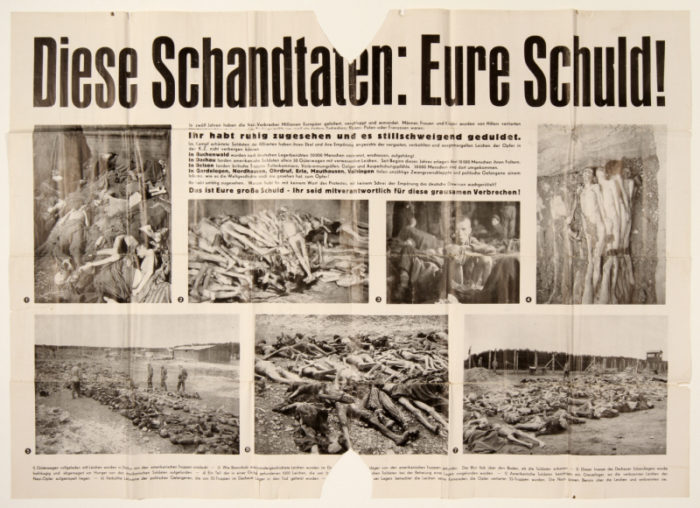
Denazification poster entitled, “These Outrages: Your Fault!”
“My Aunt Dora noticed that I wasn’t eating anything. She said to me, ‘Don’t you want some breakfast?’ I said, ‘Can I have some milk?’ She said, ‘Of course.’ I said, ‘How much milk can I have?’ She said, ‘A whole lot.’ I suddenly pulled my hands from under my seat. I grabbed the bottle and filled the glass with milk, the first full glass of milk I’d had since 1939 – twelve years earlier! When I look back, I have to smile. That was one bright moment for a glass of milk back in 1951. But in real life, happy endings are mixed. Twenty-three members of my family perished, including my father. And from approximately twenty-five thousand Jewish children from Radom and its surrounding areas, there are no more than thirty-five known survivors.”
THE HIDDEN CHILDREN
By Jane Marks
Wiesenthal was often asked to explain his motives for becoming a Nazi hunter. Wiesenthal once spent the Sabbath at the home of a former Mauthausen inmate, now a well-to-do jewelry manufacturer. After dinner his host said, “Simon, if you had gone back to building houses, you’d be a millionaire. Why didn’t you?” “You’re a religious man,” replied Wiesenthal. “You believe in God and life after death. I also believe. When we come to the other world and meet the millions of Jews who died in the camps and they ask us, ‘What have you done?’ there will be many answers. You will say, ‘I became a jeweler,’ another will say, ‘I built houses,’ but I will say, ‘I did not forget you.’”
SIMON WIESENTHAL CENTER
On the morning of February 15, I opened the window and saw a hustle and bustle in the yard…”What has happened?” I asked in surprise. “Don’t you know? The Russians marched into Grunberg last night!” I had never felt such joy before. I threw myself onto my bed, sobbing, and I could barely calm myself enough to go into town…I walked into Grünberg. What a different sight the town was now. The stuck-up German women with the ever-present shopping bags in their hands, the proud policemen, the retreating soldiers, had all disappeared from the streets. The shops had been broken into, the windows of all the houses had been shot out and doors were agape. I entered one of these ransacked houses. The rooms hadn’t been touched but the contents of the wardrobes were scattered in the middle of the room – the same way I found my apartment when the Germans were finished with it. I must say, it felt good to see a swastika-adorned home all vandalized, after what had been done to us. It was a joy to know that the proud, cruel Germans who had made millions of people homeless were rendered homeless themselves. It was a joy to search through the belongings they’d left behind, to see the traces of their hasty flight, and to know that most likely their hearts had ached when they had to leave their homes the same way it had hurt us when we had had to tie up the fruits of a life’s labor into a single bundle to take along with us. This gave me no small satisfaction.
AS THE LILACS BLOOMED
By Anna Molnar Hegedus
Himmler himself did not go so easily. At the war’s end, he brought his staff together, saying, “Well, gentlemen, you know what you have to do now? You must hide yourselves in the ranks of the Wehrmacht.” Himmler followed his own advice. Shorn of his mustache and dressed as a sergeant with a black patch over his eye, he tried to pass through British lines with six of his men, but they were caught by a random patrol. During a routine medical examination before his interrogation, Himmler bit into a cyanide capsule hidden in his mouth and died fifteen minutes later.
HUNTING EICHMANN
By Neal Bascomb
Mordecai Lichtenstein, an Auschwitz survivor who after liberation left for England, ended his deposition of May 1945 with the following comments: “Before I left Poland I wanted to see Bendzin for a last time. I wish I had not returned to this once flourishing Jewish town which has now become a ghost town. Of 30,000 Jews living there five and a half years ago, only 160 were registered on February 15th, 1945 and I assume that even these figures are too high…Now I am here [in London]…I am free, but I cannot feel happy. My parents-in-law were gassed, my younger brother, his wife and their little daughter gassed, my brother-in-law Moses hanged, and his wife and daughter died from typhus in the women’s camp. I lost sight of my second brother and my brother-in-law Wolf during the shooting [on the death march], and I do not know whether they have survived that assault. Worst of it all, however, I do not know anything about my wife’s fate.”
A SMALL TOWN NEAR AUSCHWITZ
By Mary Fulbrook
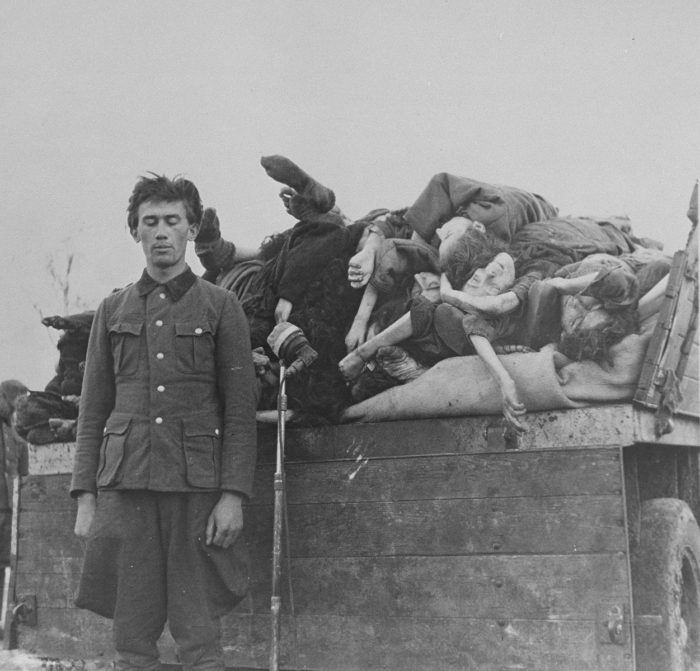
Wilhelm Dorr, formerly an SS warden in Sachsenhausen-Oranienburg, Dora-Mittelbau, and Bergen-Belsen, is forced to make an announcement for a British newsreel while standing in front of a truck filled with prisoners’ corpses.
The author of the American Army’s official history of the occupation maintained that “the Germans attributed all violent crimes to the DPs [displaced persons], and the military government reluctantly came close to agreeing with them”: in Munich, the “DPs constituted 4 percent of the population but were responsible for 75 percent of the crimes;” in Bremen form June through October “a DP population of 6,000 – 3,500 of them males over fourteen years of age – committed 23 murders, 677 robberies, 319 burglaries, and 753 thefts, with gangs operating from the camps armed with automatic weapons.” The threat of violent crime committed by DPs was the “chief reason” for arming German police in the American zone in November. (Until that time they were permitted to carry only truncheons.) A British officer recollected of Soviet deportees: “They just made mayhem. They broke into all the houses, raped all the women and drank the place dry. The Germans were quite docile and just tried to hide. The Russians weren’t organized. They were just individuals on the rampage. They’d been quite brutalized by what they’d been through as prisoners.”
GERMANY 1945
By Richard Bessel
When I [an Auschwitz survivor] brought up the subject of Auschwitz [in Germany in 1946] and the persecution of the Jews, their reactions became even more extreme. Everybody – and I mean everybody – claimed total ignorance. And yet I knew many people in Schmallenberg who had been Nazis. Even among friends and people my own age the subject was taboo. As soon as I touched on it, they’d say: “Yeah, yeah, we know. But enough is enough. You’ve got to draw the line somewhere.” You have to give the Germans credit. They really pulled off quite a coup, keeping something of such horrific dimensions repressed and under wraps.
THE UNWELCOME ONE
By Hans Frankenthal
At 3 p.m. small groups of Soviet troops were entering the camps at Birkenau and Auschwitz camp. They were welcomed with joy by the liberated prisoners. After clearing the mines, the 92nd Infantry Division of the 59th Army of the Ukrainian Front, commanded by Colonel M. Winogradow entered the camp. Approximately six hundred bodies of men and women prisoners lay on the grounds. They had died of the cold, illness, starvation, or had been shot by the SS. When the Soviet army entered the camp, there were about 1,200 prisoners at Auschwitz, 4,000 women and 1,800 men at Birkenau, and about 600 left at Monowitz. Many were so sick and exhausted that they could not be saved.
DEATH DEALER: THE MEMOIRS OF THE SS KOMMANDANT AT AUSCHWITZ
By Rudolf Höss
Edited by Steve Paskuly
Grand Admiral Dönitz, General Alfred Jodl, Field Marshal Wilhelm Keitel, and Minister of Armaments Albert Speer surrendered without protest. Fritz Sauckel, head of the slave labor program, was trapped while hiding in a cavern. On a routine patrol, an American Jewish major identified a bearded Julius Streicher, the virulently anti-Sematic publisher, who was disguised as an artist, paintbrush in hand. Hans Frank, the governor-general of Poland, attempted to hide among German POWs, but he grew so nervous over the risk of discovery that he slashed his left wrist and neck, barely surviving. Troops from the 101st Airborne uncovered Robert Ley, head of the German Labor Front, in a mountain hut very much like the one in which Kaltenbrunner was found. Foreign Minister Joachim von Ribbentrop was one of the last to be caught. The son of a wine merchant, who Ribbentrop had hoped would give him sanctuary, informed the police of his whereabouts. British soldiers arrested Ribbentrop while he was still in bed at his Hamburg hideaway. Wearing pink-and-white-striped silk pajamas, he sat up and said in flawless English, “The game is up. I congratulate you.”
HUNTING EICHMANN
By Neal Bascomb
Finally, in May 1953, he [Keith Pickus] received the following letter from the International Committee of the Red Cross [about his parents and brother]:
Dear Sir,
Further to your inquiry dated 25 November, 1952, we regret to inform you that we have received the following reply from the International Tracing Agency in Arlosen:
WEISZ Heinrich, Born 24 February, 1880
WEISZ Johanna, nee Lobl, born 15 May, 1892, and
WEISZ Ernst, born 26 May, 1928
Were transferred with Transport: AS-736, 737, 738 on 30 April, 1942, to Zamose. Transpor “AS,” dated 30 April, 1942, is considered by the Czechoslovak Ministry of Social Welfare, Prague, as a death-transport from which less than 10% are known to have returned after the war.”
With our sympathy for these sad news.
OUR ONLY HOPE
By Keith H. Pickus
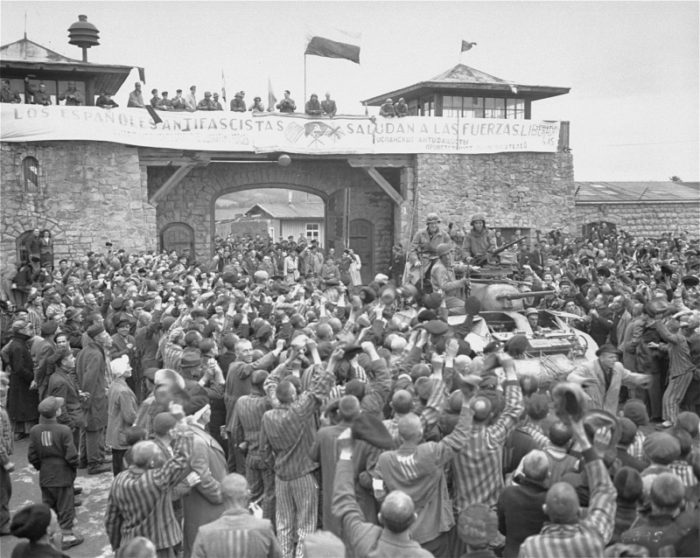
Mauthausen survivors cheer the soldiers of the Eleventh Armored Division of the U.S. Third Army one day after their actual liberation.
After a two-month stay in England, we left for Palestine on March 15. We landed in Tel Aviv on March 21, 1939. Two weeks after we arrived, my husband became ill with a mild attack of pleurisy. The pain in his legs became very intense. The pain was attributed to all the standing he had to do and the exertion of being in a concentration camp. On April 10 he got up for the first time again. We were sitting in the sun in the garden that morning for an hour; in the afternoon a heart attack ended his life. And now I’m sitting here in Palestine on Mount Canaan without my beloved life partner, without my circle of friends, without having saved even a fraction of our property. Because of the war we have lost any hope that the transfer payment [for moving funds from Germany to Palestine] can be made. I am truly “Gone with the wind.” And yet, despite the many hours of despair, despite the many hours of the most bitter attacks and the loss of faith, somewhere in the depths of my soul an absolutely unshakeable faith remains, impervious to all the terrible things that have happened to people: though we cannot see it with our eyes. This must, must all have a meaning.
JEWISH RESPONSES TO PERSECUTION
By Jürgen Mätthaus and Mark Roseman
“The unresolved question of the period of national socialism remain with us. The enormity of the crimes committed, the huge scale of victory and defeat are subjects of continuous exploration and analysis. How could one of the chief centers of the civilized world have become a torture chamber for millions of people, a country ruled by criminals so effectively that it conquered most of Europe, moving out toward other continents, planting its swastika standards from Norway to the Caucasus?” – Eugene Davidson
INSIDE THE THIRD REICH
By Albert Speer
Histories of post-1945 Germany have, understandably, focused on the transition from dictatorship to a democracy, from economic crisis to economic miracle, from Nazi barbarism to European civilization. This transition was an achievement unparalleled in modern European history: never before had a nation recovered so successfully from such terrible political, military, economic, social and moral wreckage as that left by Nazism and war. Yet for the individuals who emerged from that wreckage to build a life after death, the fundamental achievement – one that framed their memories of the end of the Second World War – was survival.
GERMANY 1945
By Richard Bessel
Adolf Hitler’s and Reichsführer-SS Heinrich Himmler’s most vicious wartime accomplice, SS-Brigadeführer (Brigadier-General) Odilo Globocnik, although dying in the spring of 1945, was a genocidal killer who is virtually forgotten, including, strangely, by most Israelis and Poles. And this despite having been one of the most bestial murderers of Jews and Poles that the 20th century was to produce. He was intricately involved in the planning and administration of the mass killing of at least 1.5 million and perhaps as many as two million people in three specially constructed but out-of-the-way killing centers – Treblinka, Sobibor, and Belzec – erected in occupied Poland to exterminate the Jews…
Brigadier Guy Wheeler described Globocnik’s ignominious end… “On the 30th May 1945, Lieutenant W. K. Hedley received information from an SS deserter that important SS officers were hiding temporarily in a mountain hut overlooking one of the lakes in the mountains just south of Paternion [Austria]…
“We drove out on the track to the lake. To avoid the noise of our vehicle alarming our quarry, we dismounted a mile or so back from where a steep and narrow path led up the hillside from the track. It took about four hours to get from the vehicles to the hut. We moved slowly and as quietly as we could and arrived at the hut just before dawn… The doors were kicked in and all the occupants were ordered out, to stand in a line, half-naked, with their hands on their heads, shivering; it was a chilly morning…
“Major Ramsay reported the success of the operation to Divisional HQ. After he had telephoned his message, he returned to the courtyard of the Schloss to start an interrogation of the prisoners. While Lieutenant Hedley had kept Globocnik in casual conversation, Ramsay, who had suspected the civilian to be lying about his identity, standing a short space between him, suddenly called his name. Globocnik half turned, then realizing that he had betrayed himself, bit on the poison phial which he had concealed in his mouth some time beforehand – collapsed and, despite the best efforts of our regimental surgeon, died very quickly.
HITLER’S MAN IN THE EAST – ODILO GLOBOCNIK
By Joseph Poprzeczny
The silence that prevailed in the fields of Belzec, Sobibor, and Treblinka after the dismantling of the camps did not last long. While the Germans sill controlled the area, and, to a greater extent, immediately after the liberation, in the summer of 1944, shameful scenes occurred on the sites of the former death camps. Rumors spread among the local population in the areas close to the camps, and even more distant places, that not all the bodies had been burned and that some of the victims had been buried with their clothes without having undergone a search. The informants claimed that in the seams and folds of the garments were hidden money, gold, and diamonds; there were also gold teeth that had been removed. It was further said that the Jews who had been prisoners in the camps had buried great treasures. This was more than enough to bring farmers swarming over the sites of the former death camps, digging and searching.
BELZEC, SOBIBOR, AND TREBLINKA
By Yitzhak Arad
A surprising proportion of the Nazi elite, including Himmler, Goering and Ribbentrop – plus technocrats such as Backe and Speer – harbored notions that they would prove so indispensable to the Allies in the post-war period that they would not just be spared but somehow be granted an active role, even a new career. They simply did not understand that certain of the Third Reich’s crimes, for which they as senior officials were clearly collectively responsible, were so extreme as to preclude forgiveness, in fact to demand their incarceration and punishment.
EXORCISING HITLER
By Frederick Taylor
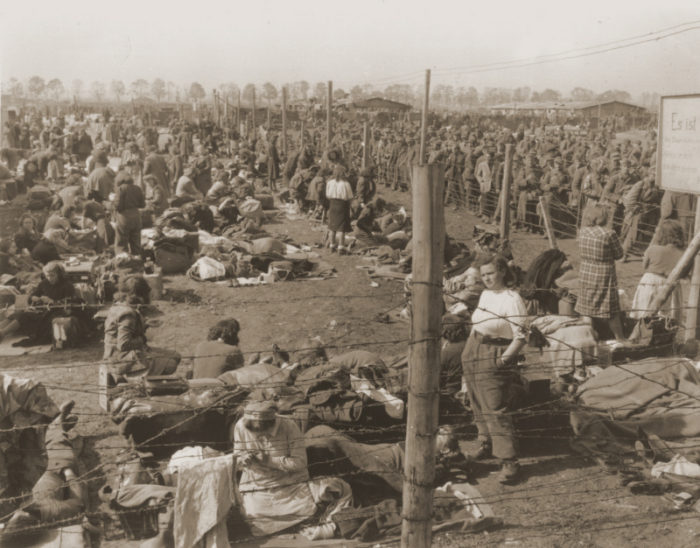
Female members of the Wehrmacht in the Third U.S. Army prisoner of war camp at Regensburg, Germany.
In the description of Hitler as he showed himself to me and to others, a good many likable traits will appear. He may seem to be a man capable and devoted in many respects. But the more I wrote, the more I felt that these were only superficial traits. For such impressions are countered by one unforgettable experience: the Nuremberg Trial. I shall never forget the account of a Jewish family going to their deaths: the husband with his wife and children on the way to die are before my eyes to this day. In Nuremberg I was sentenced to twenty years imprisonment… But the scene had already laid waste to my life. It has outlasted the verdict of the court.
INSIDE THE THIRD REICH
By Albert Speer
From 1950 to 1962, the authorities investigated thirty thousand former Nazis. But of the 5,426 who were brought to trial, 4,027 were acquitted and only 155 were convicted of murder.
THE NAZI HUNTERS
By Andrew Nagorski
After the war, the German people maintained the anti-Semitism they had been instructed to believe. But the next generation saw through it. The murdered people were not unlike them. They were not what they were made out to be. “What have you done?” they asked their parents and grandparents. “Why?” That sentiment grew with the years.
IN THE GARDEN OF BEASTS
By Erik Larson
“I had three thousand Einsatzgruppen members who every day went out and shot as many Jews as they could and Gypsies as well. I tried twenty-two, I convicted twenty-two, thirteen were sentenced to death, four of them were actually executed, the rest of them got out after a few years. The other three thousand – nothing ever happened to them. Every day they had committed mass murder.” – Benjamin Ferencz, Chief Prosecutor, Nuremberg.
THE NAZI HUNTERS
By Andrew Nagorski
Closely associated with the conclusive quality of the German defeat was the complete and obvious bankruptcy of National Socialism. Nazism had been a disaster for the peoples of Europe long before 1945, but in 1945 it also was revealed to the German people, unmistakably, as a catastrophe. It had proved itself bankrupt in every conceivable sense. In terms of its own values, it had failed miserably. A racist political ideology that asserted the alleged superiority of the German people and glorified war had guided Germany to a defeat the like of which had never before been experienced – and at the hands of allegedly inferior peoples: the Slavs and “Mongols” from the east, and the “mongrel” nation across the Atlantic. The triumphant Soviet soldiers celebrating their victory at the Reichstag and the gum-chewing American GIs driving their jeeps across Germany provided confirmation of the bankruptcy of Nazi racism.
GERMANY 1945
By Richard Bessel
After the Red Army liberated the Crimea, Lieutenant Savchenko and his unit entered the village and learned the awful truth about his family. He convened a large meeting, disinterred the dead, and gave them a proper burial. They raised a monument to them in the very center of the village. When they dug up the pit in which the Germans had buried Tsilya Savchenko, everyone saw that the murdered mother was on her knees clutching her children to herself. She was covering them with her coat, so that they would not see the butchers who were slaughtering them.
THE UNKNOWN BLACK BOOK
By Joshua Rubenstein and Ilya Altman
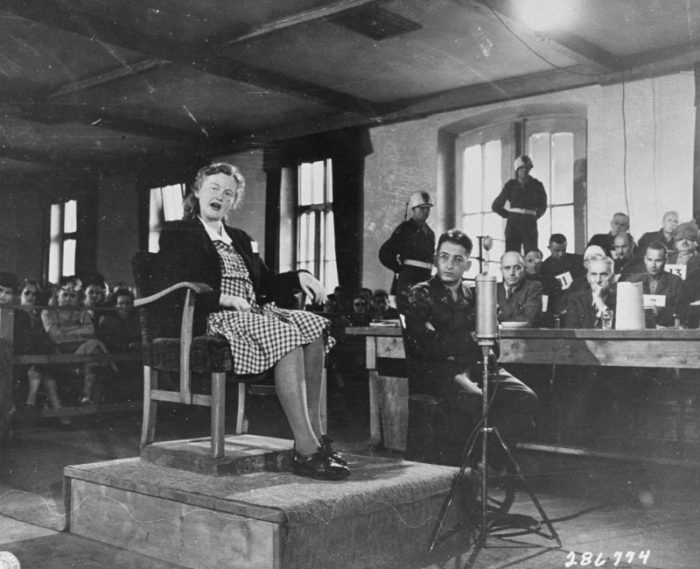
Ilse Koch [the witch of Buchenwald] testifies in her own defense at the trial of former camp personnel and prisoners from Buchenwald.
One Scholar has estimated that, since the war, of “approximately 100,000 people investigated in Germany” suspected of committing mass murder and participating in the Holocaust, “only about 6,500 were actually brought to trial, and the large majority of these before 1949.”
NAZIS AFTER HITLER
By Donald M. McKale
“Four great nations, flushed with victory and stung with injury, stay the hands of vengeance and voluntarily submit their captive enemies to the judgment of the law is one of the most significant tributes that Power has paid to Reason.” Supreme Justice Jackson, Chief Prosecutor, Nuremberg.
THE NAZI HUNTERS
By Andrew Nagorski
The widow of a man who had been executed for “undermining the war effort” on 5 January 1944 made a complaint against the two men who had denounced her husband. They denounced the man to the Gestapo after they heard him saying, “Hitler, Goring and Goebbels should be chopped into pieces for all the disaster they have brought to the people.” The case was heard by a denazification court in Frankfurt am Main. In the judgment, delivered on 10 March 1947 one of the defendants was sentenced to four years in a labor camp, the other given six months in prison for causing the arrest and murder of an opponent of National Socialism in the full knowledge that their denouncement was likely to lead to imprisonment and death.
THE GESTAPO
By Frank McDonough
Today’s world, whether we like it or not, is the work of Hitler. Without Hitler there would have been no partition of Germany and Europe; without Hitler there would be no Americans and no Russians in Berlin; without Hitler there would be no Israel; without Hitler there would be no de-colonialization, at least not such a rapid one; there would be no Asian, Arab or Black African emancipation, and no diminution of European preeminence. Or, more accurately, there would be none of all this without Hitler’s mistakes. He certainly did not want any of it. One has to go back a long way in history – perhaps to Alexander the Great – to find a man who, in a below-average short span of life, transformed the world so fundamentally and lastingly as Hitler. But what one would not find in the whole of world history is a man who, with an unparalleled and gigantic effort, achieved, as Hitler did, the exact opposite of what he had hoped to achieve.
THE MEANING OF HITLER
By Sebastian Haffner
Germany was the first country in modern history to achieve total defeat. The Nazi Regime did not surrender and German soldiers did not stop fighting, even when foreign armies were approaching the gardens of the Reich Chancellary in the center of Berlin. Never before in modern history had a nation reached the depths plumbed by Germany in 1945: its sovereignty was extinguished; its infrastructure was smashed; its economy was paralyzed; its cities reduced to piles of rubble; much of the population was hungry and homeless; its armed forces were disbanded and their surviving members were in prisoner-of-war camps; its government had ceased to exist and the entire country had been occupied by foreign armies. Germany had become a land of death. During the last year of the Second World War, more Germans died than in any other year before or since.
GERMANY 1945
By Richard Bessel
Rough estimates put the number of German women raped by Soviet forces in the final period of the war and in the months afterward at 1.9 million; there was also a huge surge of suicides by women who had been raped, often multiple times.
THE NAZI HUNTERS
By Andrew Nagorski
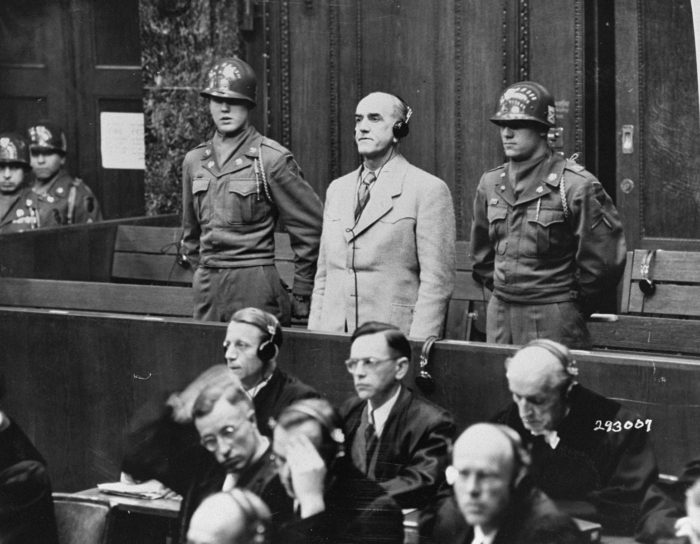
Defendant Oswald Pohl, a former SS Obergruppenfuehrer and general in the Waffen-SS, is sentenced to death by hanging by the Military Tribunal II at the Pohl/WVHA trial.
Beginning in 1945, whether placed on trial or living in freedom, the perpetrators carried on what amounted to a massive, never-ending postwar ideological, even propaganda, campaign against Jews. The perpetrators, no longer able to pursue the racial war of systematic mass murder of the Jews they had waged during World War II, continued the attack on those whom they hated the most by cheating both justice for and the truth about what the perpetrators had done.
NAZIS AFTER HITLER
By Donald M. McKale
The Federal Republic of German (FDR), created in May 1949, rejoined the democratic Western mainstream, to be followed, after five decades, by the so-called German Democratic People’s Republic (DDR) in the east. The FDR was transformed by the economic miracle symbolized by the emergence of industrial giants like AEG, BMW, Bosch, Mercedes-Benz, Siemens and VW, while the DDR languished under a centrally planned economy which, as everywhere else, totally failed to produce the rational allocations of resources that its advocates all over the world still believe in with near-religious fervor.
MORAL COMBAT
By Michael Burleigh
Immediately after the end of the Second World War, Herbert Sulzbach, then a British Army interpreter, was addressing a group of German prisoners-of-war. In the First World War he had served in the German Army, winning the Iron Cross, First Class. Being Jewish, he left Germany after the rise of Hitler, and in 1939 enlisted in the British Army. In 1945 he was a staff sergeant at Comrie, in Scotland, where 4,000 Germans were being held prisoner-of-war. Just before Armistice Day 1945 he read them John McCrae’s poem “In Flanders Fields.” He then told them how they should celebrate Armistice Day itself: “If you agree with my proposal, parade on November 11 on your parade ground and salute the dead of all nations – your comrades, your former enemies, all murdered fighters for freedom who laid down their lives in German concentration camps – and make the following vow: ‘Never again shall such murder take place! It is the last time that we will allow ourselves to be deceived and betrayed. It is not true that we Germans are a superior race; we have no right to believe that we are better than others. We are all equal before God, whatever our race or religion. Endless misery has come to us, and we have realized where arrogance leads… In this minute of silence, at 11 a.m. on this November 11, 1945, we swear to return to Germany as Good Europeans, and to take part as long as we live in the reconciliation of all people and the maintenance of peace…!’”
THE FIRST WORLD WAR
By Martin Gilbert
[Eichman’s deputy Anton Brunner] was still living in 1992 as “Herr Fischer” in Damascus, Syria, occasionally giving interviews to German magazines, still spouting anti-Sematic obscenities.
STELLA
By Peter Wyden
Nearly all the perpetrators declared they had done nothing wrong, that they had not known about the Jewish persecution until the war’s end, and that they had little or no responsibility or guilt for what happened. But in making these and other claims denying their involvement in the Holocaust, they in fact justified Nazi atrocities and anti-Semitism. They did so by asserting that the victims of the Holocaust – nearly six million European Jews – were to blame for and even deserved their fate; other perpetrators declared that the number of Jews killed had been exaggerated. Still others maintained that no systematic Nazi policy had existed to destroy the Jews. Moreover, often Nazis on trial for crimes involving the Holocaust alleged that the courts falsified or mistranslated records used against them. Some insisted that Jews conspired from vindictiveness to persecute the perpetrators unjustly. They proclaimed publicly, as the Nazi regime had done so often, that Jews formed part of a vast conspiracy to rule the world. Also, many perpetrators alleged that Germany’s and their individual wartime actions were no different from those of the Allies. In fact, they viewed themselves, their families, their friends, and Germany as victims – during the war and after – of the Allies and, of course, international and inimical Jewry.
NAZIS AFTER HITLER
By Donald M. McKale
The experience of Nazism and war, and particularly of the hardships in 1945, did not inspire most Germans to seek to build a better world, as some idealists may have hoped. Instead Germans concentrated largely on their own problems, and viewed themselves as powerless and innocent victims of forces beyond their control – of the arbitrary and sometimes violent behavior of the Allied occupation troops, of desperate shortages of food and housing, of the upsurge in crime which accompanied the end of the war, of the seeming collapse of a social and moral order. The profound disorder that faced the German people after the Nazi regime collapsed, allowed them to leave the Third Reich behind without having to confront their own role in it.
GERMANY 1945
By Richard Bessel
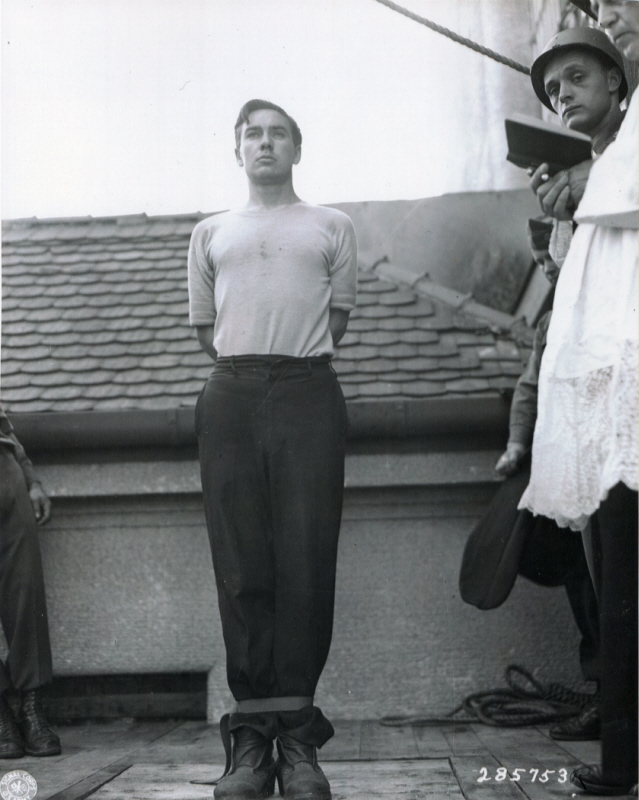
Execution of former SS-Unterscharfuehrer Josef Riegler (b. 7/5/22), a defendant at the Mauthausen war crimes trial, at the Landsberg prison. A few did not evade justice.
Few of those forced to account for their actions under Hitler showed remorse or contrition, let alone guilt. With scant exception, they showed themselves, when called to book, incapable of acknowledging their own contribution to the remorseless slide into barbarism during the Nazi era. Alongside the inevitable lies, distortions, and excuses often went, it seems, a psychological block on recognizing responsibility for their actions.
HITLER
By Ian Kershaw
A society whose historic identity owed much to militarism has become so averse to war that the only German soldier to kill a member of the Afghan Taliban after the 2003 Nato invasion was flown home for counseling.
MORAL COMBAT
By Michael Burleigh
From June 1945 onwards, the Soviets turned an unforgiving eye towards more than three million POWs, including seventy thousand officers, four hundred generals and three field marshals. They paid special attention to former members of the various branches of the SS. Thirty-seven thousand of these men were convicted of war crimes by Soviet courts. This was rough justice, which ended with either public hanging or very long sentences of hard labor in the gulags. While some of the accused, like Friedrich Jeckeln, were notorious murderers, eight Germans were also executed after a trial in Leningrad for their alleged role in the Katyn massacre.
MORAL COMBAT
By Michael Burleigh
Cologne had been bombed repeatedly during the war – 262 times altogether. The last of these raids occurred on the morning of 2 March 1945 and sent some 80,000 of the city’s inhabitants fleeing in panic. By the time the city was taken by American forces four days later, it was largely devoid of people. A registration ordered by the Americans of the city’s population in the central districts on the left bank of the Rhine revealed that, as of early April, only a little more than 44,000 civilians remained – less than 8 percent of the area’s pre-war population of 557,658. The rest had fled, been evacuated, or had died. Over the following weeks and months people returned to their home towns in steady streams from the places to which they had fled or been evacuated. In Cologne, during the summer some 6,000 people weekly were returning to the city; by July its population reached a quarter of a million, by December 1945, 447,000 residents registered. The city to which they returned was scarcely recognizable. Half of it had been destroyed.
GERMANY 1945
By Richard Bessel
In a hugely gaping paradox, deniers – who include neo-Nazis, so-called revisionist writers, and other anti-Semites – ignore that the perpetrators admitted the Holocaust happened. Instead, since the late 1940’s deniers – and others who hover on the periphery of denial – have used, in one form or another and for varying purposes, the numerous other falsehoods uttered by perpetrators at their trials and elsewhere. In so doing, almost exactly like the perpetrators, the first generation of deniers “defended” Nazi anti-Semitism and the horrors committed in its name. They blamed the Jews for the Holocaust, argued that Jews and others overstated the death toll of the victims, denied the mass of evidence showing the perpetrators’ guilt in the Holocaust, disavowed the existence of a methodical Nazi policy to exterminate all Jews the Germans could seize, and instead that German actions in the world war were no worse than those of the Allies both during and after the conflict.
NAZIS AFTER HITLER
By Donald M. McKale
Of all the people displaced in Germany in 1945, those whose predicament was most difficult were the Jews who somehow managed to survive the murderous Nazi onslaught during the war. The great majority of Jews in Germany in 1945 were of eastern European origin, primarily from Poland and Hungary, and had been brutally evacuated from the east shortly before the end of the war. Altogether, after the war ended there were roughly 50,000 Jewish survivors in Germany. Unlike most of the other DPs in Germany at the war’s end, the liberated Jews – often the only surviving members of their families – had no homes to which to return. Often in dreadful physical condition, their families murdered and their communities extinguished, they were alone, and uprooted more profoundly than just about anyone else in postwar Germany. And – unlike the foreign laborers and prisoners of war who had been held by the Germans – the surviving Jews in the main would not be repatriated in 1945. Where could they be repatriated to? One survivor described the dilemma: “The Jews looked at themselves. Who are we? Where shall we go? Everything was unclear for them. Go back to Poland? To Hungary? To wander about in these countries in the streets that the Jews had left behind, alone, without a home, always with the tragedy before their eyes… in order then to meet a former friendly neighbor who would ask ambiguously with wide eyes and with a smile, “’What, you Yankel! Are you still alive?’”
GERMANY 1945
By Richard Bessel
Despite the intelligence reports General Eisenhower had read on the German atrocities, he found himself completely unprepared for Ohrdurf. Guided by former inmates, he and his staff saw men in the hospital who had been brutally tortured and were starving, lying shoulder to shoulder, expecting nothing more than death to arrive. In a basement, he saw gallows where prisoners had been hung by piano wire long enough that their toes touched the floor, delaying death but prolonging the agony that preceded it. In one of the yards, he saw some 40 corpses, riddled with lice, stacked in rows. In an adjoining field, he saw 3,200 more corpses. Many with gunshot wounds to the back of the head, next to a pyre of wood clearly intended to destroy all traces of their existence. General Omar Bradley, who accompanied Eisenhower, could not even speak; the hard-nosed General George Patton vomited against a wall. As he left Ohrdurf, Eisenhower told his officers, “I want every American unit not actually in the front lines to see this place. We are told that the American soldier does not know what he is fighting for. Now, at least, he will know what he is fighting against.” Once back at headquarters, the shaken supreme commander sent messages to Washington and London demanding that legislators and newspaper reporters come to Ohrdurf. He wanted these crimes documented.
HUNTING EICHMANN
By Neal Bascomb
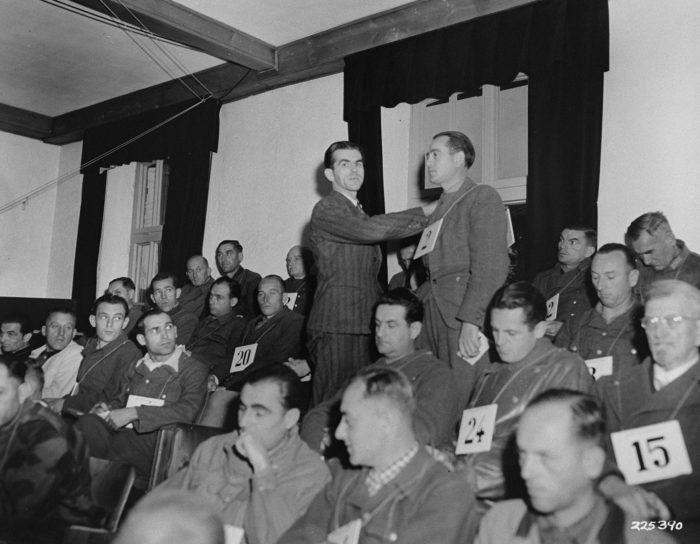
Michael Pellis, a former inmate at Dachau, identifies former SS-Obersturmfuehrer Friedrich Wilhelm Ruppert as the man responsible for selecting people to die in the crematorium, at the trial of former camp personnel and prisoners from Dachau.
On the German highways and byways one sees a veritable Voelkerwanderung – thousands, tens of thousands of men, in small groups and large, carrying bundles, carrying suitcases strapped to their backs, carrying bulging handbags, are marching east and marching west. Many wear shabby green uniforms – they are Red Army POWs, Frenchmen and Belgians who still wear their old army uniforms, now almost in tatters. Poles and Dutchmen and Serbs wear any kind of rags. Their German masters had not kept them in clothes. They were surprisingly cheerful, surprisingly orderly. Now they all march… in the direction of home.
GERMANY 1945
By Richard Bessel
The experience of defeat, which included the forced repatriation of eleven million ethnic Germans from Eastern Europe under the terms of the Yalta Agreement, meant that many Germans considered themselves among the war’s primary victims. Among these were former members of the Wehrmacht, whose wartime experiences were compounded in the case of POWs taken by the Red Army with the horrors of Soviet labor camps. Survivors were eventually released in 1955 and feted as returning heroes.
MORAL COMBAT
By Michael Burleigh
Holocaust denial – that Lipstadt termed “the growing assault on truth and memory” – originated in Europe and the United States… Today, the myth of denial is a mainstream belief, a thriving rationale and identity, for many people and some governments in the Arab and Muslim world. Also the myth is still propagated by anti-Semites in Europe and the United States.
NAZIS AFTER HITLER
By Donald M. McKale
We came up to our house to find only one cupboard and two soiled sofa cushions. There were Jew-baiting inscriptions all over the walls. We tried to clean up but this was no longer our house of old… Neighbors named someone who had taken away our furniture. We hoped we might get everything back and could stay in the village. However, the family that had carted our furniture away called us filthy Jews and chased out of their premises. I felt I could not remain in this village where I was being hurt in the midst of my misery and where pain was piling up on pain.
EDIT BRUCK, HUNGARIAN HOLOCAUST SURVIVOR
THE LAST NAZI VICTIMS
By Randolph L. Braham with Scott Miller
Altogether, the German soldiers of the Second World War would spend more man-years in captivity than they had in active service.
GERMANY 1945
By Richard Bessel


